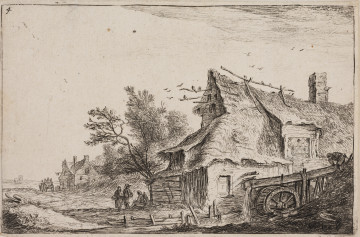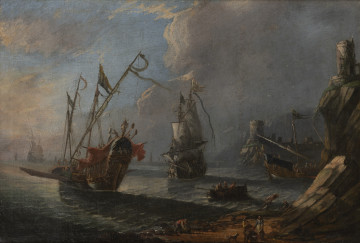
Le village au moulin a eau (Die Mühle rechts am Wasser) | Village with a mill by the water (The mill on the right by the water, Village by the water mill)
between 1626 — 1700
National Museum in Szczecin
Part of the collection: Polish landscape painting (19th–1st half of the 20th c.)
Julian Fałat (1853-1929) is one of the most prominent Young Poland representatives of landscape and genre painting. Educated at the School of Fine Arts in Kraków and at the Academy of Fine Arts in Munich, in 1895, he became the director of his alma mater, reforming its teaching system and transforming it into a modern Academy of Fine Arts.
Krajobraz górski z Bystrej [Mountain Landscape from Bystrá] is an expression of Fałat's love for his native Beskid landscape. It comes from the late period of the artist's work, who settled permanently in Bystrá in Cieszyn Silesia in 1911, after resigning from the post of director of the Academy. "A charming foothill village, just outside Bielsko. A beaten road runs along a swiftly flowing stream. In the distance, dark blue mountains covered with forest. One villa right by the road. The other one rises higher, on a rather steep hillside. In this "nest" there is Fałat's studio, the walls covered with paintings, mostly by him. Some unfinished, some reliable masterpieces." (J. Krzywoszewski, Julian Fałat, "Świat" [World] 1913, no. 39). The years spent in Bystrá resulted in many landscapes devoted to the area, usually evoking a vast mountainous terrain with a winding brook, often in winter scenery. The panoramic, horizontal composition of Krajobraz..., built from parallel zones, is dominated by the intensified blue of almost symmetrically framed, gentle mountain slopes. A horizontal streak of fog emphasizes the horizon line, which Fałat characteristically divides his compositions into two areas. The synthetic character of the autumn landscape is broken by the introduction of staffage in the form of silhouettes of people busy with field work and grazing animals, suggested only by small patches. The transience of mists and drifting fogs reveals the influence of impressionism, visible also in the use of contrasting juxtapositions of blues in the parts of shaded slopes, greens and browns, accents of red and nuanced pink and broken whites. Fałat's work was influenced by the art of the Far East, assimilated among others thanks to his trip to China and Japan, which he visited in 1885 as the first Polish artist. In Krajobraz... he assimilates the horizontalism of lines and diagonal spatial arrangements typical of compositions by Japanese masters ukiyo-e.
Anna Hałata
Author / creator
Dimensions
cały obiekt: height: 99 cm, width: 54 cm
Object type
painting
Technique
drawing and painting technique
Material
paper, aquarel
Creation time / dating
Creation / finding place
Owner
The National Museum in Lublin
Identification number
Location / status

between 1626 — 1700
National Museum in Szczecin

1600 — 1650
National Museum in Szczecin
1911
National Museum in Lublin
DISCOVER this TOPIC
Museum of King Jan III's Palace at Wilanów
DISCOVER this PATH
Educational path